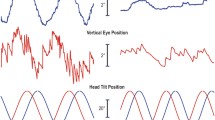Abstract
If horizontal saccades or smooth-pursuit eye movements are made with the line-of-sight at different elevations, the three-dimensional (3D) angular rotation axis of the globe tilts by half the vertical eye eccentricity. This phenomenon is named ”half-angle rule” and is a consequence of Listing’s law. It was recently found that the ocular rotation axis during the horizontal vestibulo-ocular reflex (VOR) on a turntable also tilts in the direction of the line-of-sight by about a quarter of the eye’s vertical eccentricity. This is surprising, since, in a ”perfect” VOR, the angular rotation axis of the eye should be independent from the position of the eye to fully compensate for the 3D angular head rotation. We asked whether this quarter-angle strategy is a general property of the VOR or whether the 3D kinematics of ocular movements evoked by vestibular stimulation would be less eye-position dependent at higher stimulus frequencies. Nine healthy subjects were exposed to horizontal head impulses (peak velocity ∼250°/s). The line-of-sight was systematically changed along the vertical meridian of a tangent screen. Three-dimensional eye and head movements were monitored with dual search coils. The 3D orientation of the angular eye-in-head rotation axis was determined by calculating the average angular velocity vectors of the initial 10° displacements. Then, the difference between the tilt angles of the ocular rotation axis during upward and downward viewing was determined and divided by the difference of vertical eccentricity (”tilt angle coefficient”). Control experiments included horizontal saccades, smooth-pursuit eye movements, and eye movements evoked by slow, passive head rotations at the same vertical eye eccentricities. On average, the ocular rotation axis during horizontal head-impulse testing at different elevations of the line-of-sight was closely aligned with the rotation axis of the head (tilt angle coefficient of pooled abducting and adducting eye movements: 0.11±0.17 SD). Values for slow head impulses, however, exceeded somewhat the quarter angle (0.33±0.12), while smooth-pursuit movements (0.50±0.09) and saccades (0.44±0.11) were closest to the half angle. These results demonstrate that the 3D orientation of the ocular rotation axis during rapid head thrusts is relatively independent of the direction of the line-of-sight and that ocular rotations elicited by head impulses are kinematically different from saccades, despite similar movement dynamics.
Similar content being viewed by others
Author information
Authors and Affiliations
Additional information
Received: 17 July 1998 / Accepted: 17 May 1999
Rights and permissions
About this article
Cite this article
Palla, A., Straumann, D. & Obzina, H. Eye-position dependence of three-dimensional ocular rotation-axis orientation during head impulses in humans. Exp Brain Res 129, 127–133 (1999). https://doi.org/10.1007/s002210050943
Issue Date:
DOI: https://doi.org/10.1007/s002210050943




